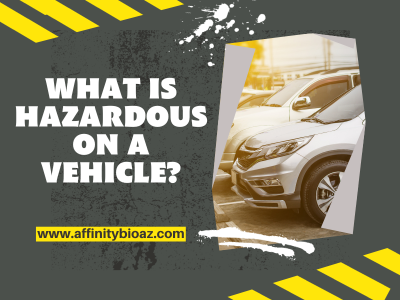 Vehicles are an integral part of our daily lives, providing us with convenience and mobility. However, it’s essential to understand that vehicles can also pose hazards if not properly maintained or operated. Let us explore what is hazardous on a vehicle, highlighting various potential dangers that motorists and pedestrians should be aware of.
Vehicles are an integral part of our daily lives, providing us with convenience and mobility. However, it’s essential to understand that vehicles can also pose hazards if not properly maintained or operated. Let us explore what is hazardous on a vehicle, highlighting various potential dangers that motorists and pedestrians should be aware of.
- Faulty Brakes
One of the most hazardous aspects of a vehicle is its braking system. Faulty brakes can lead to accidents and collisions. Brake pads, rotors, and brake fluid should be routinely inspected and maintained to ensure they function correctly. Unusual noises, spongy brake pedals, or decreased braking efficiency can be signs of brake issues that require immediate attention.
- Worn Tires
Tires are the only part of a vehicle that makes contact with the road, making their condition critical to safety. Worn or improperly inflated tires can result in reduced traction, decreased handling, and increased braking distances. To prevent accidents, regularly inspect tire tread depth, check for signs of damage or uneven wear, and maintain proper tire pressure.
- Faulty Lights and Signals
Proper lighting and signaling systems are crucial for safe driving. Burnt-out headlights, taillights, brake lights, and turn signals can make it difficult for other drivers to see your vehicle’s intentions, increasing the risk of accidents. Regularly check and replace malfunctioning lights and signals to ensure your vehicle remains visible to others on the road.
- Malfunctioning Steering and Suspension
Issues with a vehicle’s steering and suspension can result in loss of control, leading to accidents. If you notice excessive play in the steering wheel, vibrations, or a bumpy ride, it’s crucial to have these components inspected and repaired promptly.
- Exhaust Leaks
Exhaust leaks can release harmful gases such as carbon monoxide (CO) into the cabin, posing serious health risks to the vehicle’s occupants. Regularly inspect and maintain the exhaust system, including the muffler and catalytic converter, to prevent leaks and ensure the safe operation of the vehicle.
- Fuel Leaks
Fuel leaks are not only hazardous for the environment but can also lead to fires and explosions. If you detect the smell of gasoline or notice puddles of fuel under your vehicle, it’s imperative to address the issue immediately and seek professional assistance.
- Electrical Issues
Modern vehicles rely heavily on complex electrical systems. Faulty wiring or electrical components can cause a wide range of hazards, from starting problems to fires. If you experience issues such as a dead battery, flickering lights, or electrical malfunctions, consult a qualified mechanic to diagnose and repair the problem.
- Inadequate Airbags and Seatbelts
Safety features like airbags and seatbelts are designed to protect vehicle occupants during accidents. It is hazardous when these features are defective or not in proper working condition. Regularly inspect and maintain airbags and seatbelts to ensure they function as intended.
Understanding what is hazardous on a vehicle is crucial for maintaining road safety. Regular vehicle maintenance, including brake inspections, tire checks, and addressing any malfunctioning components, can help prevent accidents and ensure the safety of both drivers and pedestrians. Remember that safety should always be a top priority when operating or maintaining a vehicle.
For more information on hazardous materials, or to schedule our team to assist you with and hazardous clean up services, please feel free to contact our office at any time.

